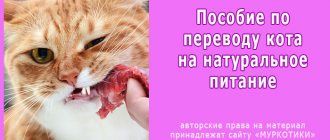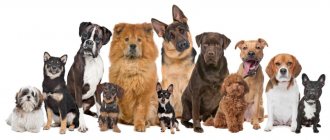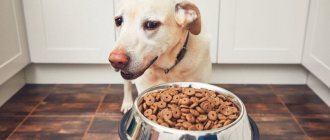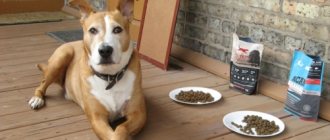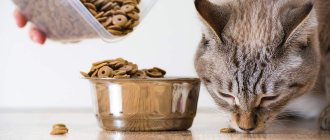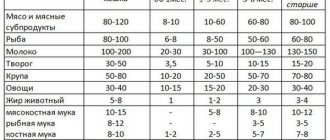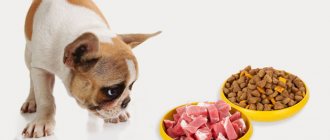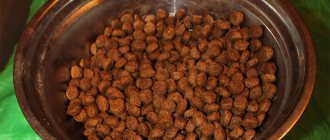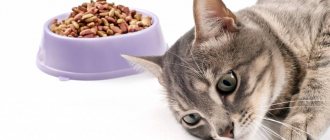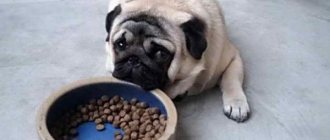Today I will share my experience and talk about how to switch a dog to natural food. I hope that this information will be useful for dog breeders whose pets, for one reason or another, refuse to consume dry food.
I would like to note right away that this is not a matter of one day, and this process will take you some time and effort, because switching a dog from dry to natural feeding is much more difficult than vice versa.
The difficulty is that when feeding dry food, the usual activity of the pancreas decreases, since the food has already been sufficiently processed. The pancreas does not need to activate all its processes and secrete pancreatic juice to break down, for example, meat protein.
After switching to natural food, your pet’s body needs some more time for all the functions of the pancreas to acquire their natural properties. Therefore, you should be patient so as not to harm the tail.
Pros and cons of a natural diet
The natural diet menu is quite similar, so you don’t need to be a culinary genius to prepare it. This type of feeding has the following advantages:
- prevention of dental and oral diseases, based on a constant combination of soft and hard foods;
- absence of dangerous ingredients, because it is you who control the quality of products and the composition of dishes;
- easy digestion due to the natural origin of food;
- the ability to adjust the menu to suit any therapeutic diet.
There are also disadvantages. These include the need for daily food preparation and the difficulty of complying with the norms of KBZHU (calories-proteins-fats-carbohydrates). This forces you to spend a considerable part of your personal time and buy additional vitamin complexes.
In what situations should you switch your dog to natural?
Dry feeding is convenient and safe, so a return to natural feeding is usually explained by a sudden refusal of food or health problems. The latter include:
- apathetic and lethargic state;
- various digestive disorders (diarrhea, constipation, nausea, vomiting);
- deterioration in coat quality (dullness, loss);
- deficiency or surplus of body weight.
If you notice any of the above symptoms, be sure to take your pet to the vet. If he does not have concomitant diseases, then the problem of his malaise lies in the food. In this case, they either change the manufacturer or return to the “natural” one.
Possible complications
Sometimes a dog refuses dry food in favor of natural food on the first day. If she is completely healthy, then the process can be reduced from a week to 3-4 days. If you have any diseases, it is recommended to consult a professional veterinarian before making any changes to your diet.
Perhaps your pet is allergic to some component. For example, some dogs have a persistent intolerance to an ingredient such as chicken, which means that natural food with such an ingredient will definitely not benefit them. When purchasing Feed Bro! food, you can be sure that there are no allergy-causing foods, including chicken.
During the diet change process, dogs may experience loose stools. This is normal, so don’t worry and don’t give up on the idea of natural feeding. This is a completely normal reaction of the body to new components and microelements supplied with normal food. It’s another matter if the relaxation does not stop after a week.
Knowing how to properly feed your dog natural food, you can easily switch your pet to healthy food. You will notice that his condition will noticeably improve, he will become healthier and more active, and you will not worry about the negative effects of dry food. By choosing natural food to feed your animal, you will provide your pet with the ideal set of daily vitamins, minerals and nutrients so that he has good health and always a well-groomed appearance. Change your pet's diet correctly, and you will receive his endless love and gratitude.
How to switch a dog from food to natural food
There are only two transition options: sharp and smooth. Their advantages and disadvantages will be discussed below.
REFERENCE!
The percentage ratio between meat, dairy products, cereals and fruits and vegetables should be 55:30:10:5.
Selecting the right products
To switch to natural nutrition, it is recommended to choose foods that are easily digestible. These include:
- low-fat kefir, natural yogurt without additives;
- boiled vegetables (zucchini, pumpkin, carrots) and fresh cucumbers;
- lean beef, chicken and turkey;
- rice and oatmeal.
Introduce the above gradually and be sure to monitor the body’s reaction. If itching, hair loss, redness of the skin and other alarming symptoms appear, the allergen will have to be urgently excluded.
Abrupt transition: pros and cons
Suitable for animals who are already familiar with “natural” in the past. There is one plus here - speed, but there are many more minuses. These include:
- disruption of the gastrointestinal tract due to the lack of an adaptation period;
- refusal of food, provided that the dog sees the offered food for the first time;
- apathy or aggression due to stress.
Veterinarians do not recommend this method, because after it the animal often has to be urgently taken to the veterinary clinic. For this reason, it is better to choose a long but safer smooth transition.
Smooth transition: pros and cons
Despite the duration, a smooth transition has one big advantage - easier adaptation to the new diet. This method does not involve replacing the usual food one day, so it is much easier for the pet to get used to the new conditions. In this case, the diagram looks like this:
- the first 4 days – 75% “drying” and 25% “natural”;
- Days 5-9 – 50% of each type;
- Days 9-14 – 25% dry and 75% natural.
After 2 weeks, the pet is fed only “natural” food. During the transition, it is recommended to increase the frequency and duration of walks so that the pet does not go crazy right at home.
Translation scheme
When thinking about how to switch a dog from food to natural food, owners are looking for the optimal solution. Each animal is unique, so it is quite difficult to adapt a general method to a specific pet.
The most suitable scheme for switching dogs to natural food is considered to be:
- It is recommended to start the first week with cottage cheese, rice, chicken, beef, buckwheat, boiled fish peeled from scales and bones, rolled oats and carrots. In the evening you can give dry food.
Important! If one of the foods is poorly digested or the dog does not like it, you should temporarily exclude it from the diet.
- From the second week, the proportion of natural food increases, and the amount of dry food gradually decreases. It is recommended to give more dairy products (yogurt, cottage cheese, kefir). You should not give too many vegetables, otherwise vomiting or diarrhea may occur.
Important! Dogs that were previously pampered with natural food adapt much more easily to the new diet.
It is quite difficult to switch your pet to natural food, because the owner will have to independently control the amount of vitamins and nutrients the pet receives. However, for the dog itself, natural food is much better, healthier and more enjoyable.
Possible consequences and problems
Replacing your usual dishes is always a big stress for the body. Most often it is expressed either through digestive disorders or through a four-legged hunger strike.
Stool upset or nausea
The need to reconstruct the pancreas has already been mentioned above. In addition, a lower level of stomach acidity, i.e. pH, is required for easy digestion. Changes take about 7-10 days, and until then, diarrhea, constipation and vomiting are completely normal.
It is worth sounding the alarm only in 2 cases: when symptoms persist for more than 10-14 days or when the frequency of their occurrence increases. Remember that frequent bouts of vomiting and uncontrolled diarrhea can lead to severe dehydration and even death.
Refusal of new products
Getting used to it takes time, so don’t be afraid of refusing food offered in the first days. The most effective way to fight is an instructive hunger strike. The recommended limit for adult animals is 2-3 days, and for puppies - only 1 day.
REFERENCE!
The most important picky animals are representatives of small breeds. Finding dishes that suit them can only be done through trial and error.
The second recommendation is mandatory soaking of dry granules. This not only accustoms the dog to softer food, but also to new tastes, and also eliminates tricky food selection.
Additional recommendations
If you decide to switch your pet to natural dog food, check out the useful information:
- The dog will consume much less water, since natural food contains it in excess, unlike dehydrated pads.
- Also, you should not be afraid that your dog will ask for a walk more often, because his body now accumulates much more moisture.
- Natural food should be introduced gradually, observing how the pet’s stomach and intestines react to new foods. Perhaps it is better to exclude something from the diet.
- The transfer will occur much faster if you previously fed the dog with natural products. In the case where the food was completely mixed, the pet will very quickly stop consuming dry food.
- Refrain from the idea of adding seasonings, hot and spicy spices to food, treating your pet with sweet or fatty foods, giving sweets, chocolate, etc. Some common human foods are poisonous to dogs.
- Monitor the temperature. If the food was in the refrigerator before feeding, it must to room temperature But you shouldn’t get carried away: dogs often eat very greedily, and hot food can burn the esophagus.
The subtleties of switching to a raw diet
When switching to “natural” you must follow several important rules. These include:
- Gradual introduction of new products. To avoid allergies, add them no more than once every 2-3 days.
- Serve as one dish. It should be distinguished from mixed nutrition on an ongoing basis. After cooking, mix everything thoroughly so that the dry granules and regular food take on the same consistency and temperature. This makes the final dish easier to digest.
- Smooth refusal of mixing. From the 9th day, it is better to serve “drying” separately in the morning, and divide the portion of “natural” into daytime and evening meals.
- Thoroughly boil the meat before serving. You can proceed to simple scalding with boiling water only if there is no negative reaction from the body.
- Mandatory throwing away uneaten food. Otherwise, the leftover food will simply spoil.
If you have any doubts or questions, do not hesitate to contact your veterinarian. Animals with chronic illnesses may require slightly different conditions.
What you definitely need to know
If you have decided to switch your dog to natural feeding, then the following information will be useful to you:
- With natural food, more moisture enters the pet’s body, and it needs to drink less. Therefore, there is no need to worry if your four-legged dog begins to drink less. But this does not mean that the water needs to be removed altogether. There should be water in the bowl at all times, regardless of whether your furry friend eats natural or dry food. Introduce new foods into the diet gradually, studying the reaction of your pet’s body.
- If before you still pampered your sand with natural products, then the transition will take less time than if the tailed one ate exclusively dry food.
- The transfer may be accompanied by diarrhea, partial indigestion of certain foods, therefore, during the transfer from one food to another, be sure to give the dog probiotics (food products and dietary supplements containing live microcultures) that help improve digestion.
- Since natural food contains more moisture, your pet may need to go to the toilet more often. Therefore, do not scold him, but be patient until everything returns to normal and the functioning of the gastrointestinal tract returns to normal.
- Well, if, when switching to natural food, the dog refuses to eat at all, has constant diarrhea and vomiting, then you definitely need to contact a veterinarian to identify the reasons why switching to natural feeding is difficult.
Well, in general, this whole process occurs individually for each animal. Monitor your pet carefully during this time. And when your dog finally starts eating natural food, you will see for yourself how he will immediately become happy and cheerful.
Daily portion volume
The serving size depends on the weight and age of the animal. It can be calculated in grams and calories. The norm for children is 6-7% of body weight, and for adults – 3-5%. To calculate calories, you need to know your age or breed:
- less than 2 months – 220 calories per 1 kg, 2-3 months – 265, 3-4 months – 201, 4-8 months – 136, 8-12 months – 100;
- giant - 53 calories per 1 kg, large - 60, medium - 69, small - 84, dwarf - 110.
Based on averages, you can calculate the norms for a Pembroke Welsh Corgi: a 4-month-old puppy weighing 7 kg and an adult dog weighing 12 kg. They will be 420-490 g of food, or 952 calories, and 360-600 g of food, or 828 calories, respectively.
IMPORTANT!
Avoid feeding only meat. Wild wolves are indeed carnivorous, but 70% of their diet consists of small rodents. Along with them, processed grains and spikelets enter their body. At home, they are replaced by cereals.
The presented formulas are quite easy to use and do not require any additional knowledge. It is only important to note that the obtained values serve as a guide. In addition to age and body weight, it is recommended to consider your pet's activity level and health.
If the calorie content calculated by the formula is not enough for him, which will be noticeable by sudden weight loss, do not be afraid to increase it. To be more reliable, consult your veterinarian and ask him to choose an individual menu for your dog.
Do you need vitamins and supplements?
It is impossible to get everything you need from regular food, therefore, in addition to standard foods, you should add the following main sources of natural vitamins to your diet:
- raw seaweed;
- wheat germ flour;
- fish fat;
- ground egg shells;
- Brewer's yeast.
To avoid vitamin deficiency, all animals eating natural foods should be tested for essential vitamins. If deficiencies are identified, the veterinarian may recommend ready-made vitamin and mineral complexes in tablet form.
Transferring a puppy from dry food to natural food
The transfer scheme for a puppy and an adult is identical. The only difference is the time it takes to get used to it. Instead of 14 days, it is recommended to choose a longer interval, increasing the duration of each stage to 7 days.
Regardless of the age of your pet, be sure to be patient and do not scold him if he refuses the food offered. Be a little chef and try to come up with more appetizing alternative combinations. Over time, you will definitely find something that your four-legged one will approve of.
Do you like the article? 0
Dry food is healthy and not so good
Although dry food has been on the menu for dogs all over the world for almost 160 years (since 1860), there are owners who do not trust ready-made industrial products. The Internet is full of angry reviews about purchased “dry food” (like “dry food killed my dog”, etc.). Indeed, industrial feed can be harmful, but only if it is an economy-class product. It contains the following unhealthy components: soybeans, cheap and not very necessary grains for dogs (like corn), by-products of dubious quality (extract from meat waste from sick or even dead animals). The most annoying thing is that economy class food is the most advertised. Their manufacturers promise dogs health and longevity, although in reality such “drying” is actually poison for pets, seasoned with flavorings and taste enhancers.
Photo: dry dog food | Dreamstime.com
The situation is completely different with high-quality feed. For example, in popular holistic formulas (“Akana”, “Grandorf”, “Savarra”, etc.), the first place in the composition is occupied by fresh and dehydrated meat, eggs, vegetables, cereals, poultry fat, amino acids, antioxidants and lactobacilli, microelements. Of course, such dry food will not harm the dog, but will bring satiation and benefit. True, these products have several relative disadvantages: they are not on the shelves of large stores, they are not always found in pet stores, and the cost of quality food is always high. In addition, pets, accustomed from childhood to cheap food, which contains many harmful additives, sometimes refuse to eat holistic and premium food for a long time (probably, they simply seem tasteless to dogs, because there are no fragrances or flavor enhancers in the composition).
